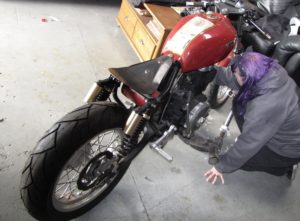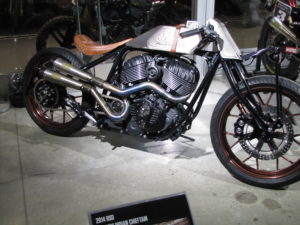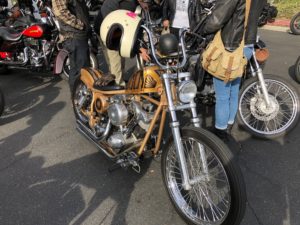The Build Part 1: Tips from a pro

So here we go on our journey to get you from person-in-the-cubicle to FRONT PAGE of your favorite custom motorcycle mag.
Maybe it’s BikeEXIF, maybe it’s Croig’s Instgram feed. Maybe it’s HotBike, Basketcase, or Sideburn.
What ever your flavor may be, Junk and Whammer are here to help you along the way. We’re not pros by any means, so we’ve enlisted the help from a true custom guru and pro builder: Cerberus Moto’s Dave Hargreaves.

Jennifer gets down with the Monkey Photo/Creative Riding
Dave imparted a lot of valuable information and years of wisdom into one short phone call to get you started. We talked about it in episode 103 of the podcast. In case you didn’t hear it, the details are below:
Section A is for the bike:
1. What is your goal?
- What do you want to build?
Certain bikes lend themselves to certain styles right out of the factory. There’s a reason you used to see 5000 Bonneville and CB750 cafe racers. It’s the same reason that you rarely see DRZ400 Choppers. - Once you know what style if bike you want to build, you can go in search of a proper donor vehicle.
2. Get Inspired
- Go to the internet for inspiration. The first step toward your vision can be inspired by what others have done with your muse. See what others have done right and wrong with your project’s foundation.
- See what patterns pop up. There is a reason that the research you did for step one kept yielding similar results. If you search for choppers, chances are the results you’ll run across are 90% Harley-Davidson. Searching for Yamaha bobbers will likely showcase the whole Virago and XS lines from decades past.
3. What’s Available?
- According to Dave at Cerberus, availability doesn’t stop at your bike. He explained that parts (OEM and aftermarket) also need to be on hand if you’re going to succeed. Nothing sucks worse than buying a rare bike, tearing it down, then finding out that no one makes anything for it anymore.
- Dave used a recent staple of the internets as an example; the CX 500: “It was a piece of crap when it was new, and there are certainly no parts available for it now.”
- The FT500 Ascot “box of rocks”: The Ascot is an often sought-after model due to the popularity of Flat Track and builders adopting tracker styling. The only problem, according to Dave, is the electric starter. Actuated via six reduction gears and a poorly manufactured pinion gear and bearing, the owner would often thumb the start button only to hear a sound like someone shaking a box of rocks. No kick start version was optional, and it’s reco- mmended to replace the pinion and bearing at every service interval…
- Recalls are also important to take into consideration on older bikes. It’s likely that parts are not going to be available for a recall on a bike that’s 40 years old and has problems.

Photo/Bri Viffer
Section B is for the builder
1. Set a budget:
- Set a good reasonable budget.
- Expect to add 50% of that budget back to the total. If you had a $1000 budget, expect your build to at least cost $1500. The numbers start to go up very quickly as your budget increases. $5000 +50% = $7500!!
- You will never spend as little as you think, and if you did, you’ve cut corners and will find out later.
2. Inspirational Goal:
- Similar to step 2 ‘Get Inspired” for the bike, now is the time for you to make sure that you’re about to take your project in the right direction.
- Dave says a simple test is the “tattoo test”: Look at a picture of a bike that is in the same style as you want to build yours. Study it. Examine it for hours. Commit it to memory. Do this for 30 days. If you still like the look and style of the bike after a month of mulling it over and over in your head – then build it. Several poorly-themed tramp stamps could have been prevented if people followed the same advice.
3. Don’t be afraid to ask questions:
- Dave says that there’s no such thing as a dumb question. The dumbest question is the one that wasn’t asked.
- Another tip: If you don’t stop to ask questions then, when you inevitably fail, people like Dave end up getting bikes for real cheap.
Well, that’s The Build Part One, in the bag.
For more tips from Dave and to hear his and Jennifer’s story, and the origins of Cerberus Moto, check out episode 64 of the podcast.
There have been a lot of changes at Cerberus since we interviewed Dave and Jennifer, so be sure to follow their Instagram and Facebook pages to keep up with all of the community events and classes that Cerberus offers.

Photo/Creative Riding

